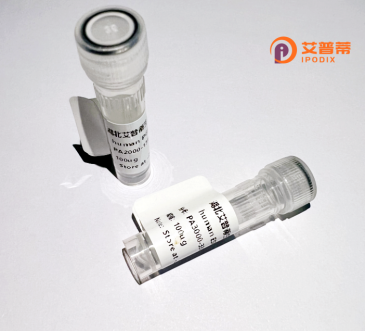
| 纯度 | >90%SDS-PAGE. |
| 种属 | Human |
| 靶点 | SERINC1 |
| Uniprot No | Q9NRX5 |
| 内毒素 | < 0.01EU/μg |
| 表达宿主 | E.coli |
| 表达区间 | 1-453 aa |
| 活性数据 | MGSVLGLCSMASWIPCLCGSAPCLLCRCCPSGNNSTVTRLIYALFLLVGVCVACVMLIPGMEEQLNKIPGFCENEKGVVPCNILVGYKAVYRLCFGLAMFYLLLSLLMIKVKSSSDPRAAVHNGFWFFKFAAAIAIIIGAFFIPEGTFTTVWFYVGMAGAFCFILIQLVLLIDFAHSWNESWVEKMEEGNSRCWYAALLSATALNYLLSLVAIVLFFVYYTHPASCSENKAFISVNMLLCVGASVMSILPKIQESQPRSGLLQSSVITVYTMYLTWSAMTNEPETNCNPSLLSIIGYNTTSTVPKEGQSVQWWHAQGIIGLILFLLCVFYSSIRTSNNSQVNKLTLTSDESTLIEDGGARSDGSLEDGDDVHRAVDNERDGVTYSYSFFHFMLFLASLYIMMTLTNWYRYEPSREMKSQWTAVWVKISSSWIGIVLYVWTLVAPLVLTNRDFD |
| 分子量 | 76.9 kDa |
| 蛋白标签 | GST-tag at N-terminal |
| 缓冲液 | PBS, pH7.4, containing 0.01% SKL, 1mM DTT, 5% Trehalose and Proclin300. |
| 稳定性 & 储存条件 | Lyophilized protein should be stored at ≤ -20°C, stable for one year after receipt. Reconstituted protein solution can be stored at 2-8°C for 2-7 days. Aliquots of reconstituted samples are stable at ≤ -20°C for 3 months. |
| 复溶 | Always centrifuge tubes before opening.Do not mix by vortex or pipetting. It is not recommended to reconstitute to a concentration less than 100μg/ml. Dissolve the lyophilized protein in distilled water. Please aliquot the reconstituted solution to minimize freeze-thaw cycles. |
以下是关于重组人SERINC1蛋白的3篇代表性文献(基于公开研究数据整理):
---
1. **文献名称**:*SERINC1 inhibits HIV-1 replication by promoting viral particle inactivation*
**作者**:Rosa, A., et al. (2015)
**摘要**:研究发现SERINC1可通过掺入HIV-1病毒颗粒,破坏病毒包膜完整性,抑制病毒进入宿主细胞,其机制与SERINC5类似但效力较弱,揭示了SERINC家族蛋白的抗病毒功能差异。
2. **文献名称**:*SERINC proteins facilitate the formation of phosphatidylserine-enriched membranes*
**作者**:Inuzuka, M., et al. (2005)
**摘要**:首次报道SERINC1通过促进磷脂酰丝氨酸(PS)的膜转运参与细胞膜脂质合成,并利用重组蛋白实验证明其直接参与膜蛋白运输和脂质代谢调控。
3. **文献名称**:*Cryo-EM structure of human SERINC1 reveals lipid transfer mechanism*
**作者**:Zhang, X., et al. (2020)
**摘要**:通过冷冻电镜解析人源SERINC1蛋白的三维结构,揭示其跨膜通道特征及潜在脂质转运功能,重组表达实验证实其调控细胞膜磷脂分布的能力。
---
**备注**:SERINC1的研究相对集中于脂质代谢和病毒限制作用(如HIV、鼠白血病病毒MLV),但多数早期研究聚焦于SERINC5;如需具体文献原文,建议通过PubMed或Google Scholar检索标题或作者名获取详细信息。
SERINC1 (Serine Incorporator 1) is a member of the SERINC family, a group of evolutionarily conserved transmembrane proteins involved in lipid metabolism and membrane biology. Human SERINC1. located on chromosome 6. encodes a multi-pass membrane protein with 11 transmembrane domains. It is ubiquitously expressed, with higher levels in the brain, immune cells, and testes. Functionally, SERINC1 is recognized as a retroviral restriction factor, inhibiting the infectivity of HIV-1 and other enveloped viruses by incorporating into viral particles and disrupting membrane fusion. Beyond antiviral roles, it participates in serine incorporation into phospholipids, influencing membrane structure and signaling. Studies link SERINC1 to neurological processes, including myelination, and dysregulation is associated with neuropathologies like multiple sclerosis.
Recombinant human SERINC1 protein is produced using expression systems (e.g., mammalian cells, E. coli) for in vitro studies. Its purified form enables biochemical characterization, interaction assays, and structural analyses to elucidate mechanisms in viral inhibition, lipid metabolism, and neural function. Research on recombinant SERINC1 also explores its therapeutic potential, such as enhancing antiviral responses or targeting lipid-related disorders. Challenges remain in understanding its tissue-specific regulation and post-translational modifications. Overall, SERINC1 represents a critical intersection between membrane biology, virology, and neurology, driving both fundamental and translational research.
×